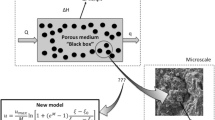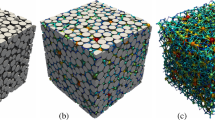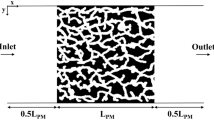Abstract
The understanding and prediction of preferential fluid flow in porous media have attracted considerable attention in various engineering fields because of the implications of such flows in leading to a non-equilibrium fluid flow in the subsurface. In this study, a novel algorithm is proposed to predict preferential flow paths based on the topologically equivalent network of a porous structure and the flow resistance of flow paths. The equivalent flow network was constructed using Poiseuille’s law and the maximal inscribed sphere algorithm. The flow resistance of each path was then determined based on Darcy’s law. It was determined that fluid tends to follow paths with lower flow resistance. A computer program was developed and applied to an actual porous structure. To validate the algorithm and program, we tested and recorded two-dimensional (2D) water flow using an ablated Perspex sheet featuring the same porous structure investigated using the analytical calculations. The results show that the measured preferential flow paths are consistent with the predictions.
Similar content being viewed by others
References
Šimůnek J, Jarvis N J, van Genuchten M T, et al. Review and comparison of models for describing non-equilibrium and preferential flow and transport in the vadose zone. J Hydrol, 2003, 272: 14–35
Zhang Y, Yao F, Xu D, et al. Stochastic simulation on preferential seepage channels in water-flooding reservoirs. Electron J Geotech Eng, 2015, 20: 803–812
Birk S, Liedl R, Sauter M. Karst spring responses examined by process-based modeling. Groundwater, 2006, 44: 832–836
Sinkevich M G, Walter M T, Lembo A J, et al. A GIS-based ground water contamination risk assessment tool for pesticides. Ground Water Monit Rem, 2005, 25: 82–91
Wang Z, Jury W A, Tuli A, et al. Unstable flow during redistribution. Vadose Zone J, 2004, 3: 549–559
Gomez H, Cueto-Felgueroso L, Juanes R. Three-dimensional simulation of unstable gravity-driven infiltration of water into a porous medium. J Comp Phys, 2013, 238: 217–239
Beven K, Germann P. Macropores and water flow in soils revisited. Water Resour Res, 2013, 49: 3071–3092
Jarvis N J. A review of non-equilibrium water flow and solute transport in soil macropores: Principles, controlling factors and consequences for water quality. Eur J Soil Sci, 2007, 58: 523–546
Armstrong R T, Berg S. Interfacial velocities and capillary pressure gradients during Haines jumps. Phys Rev E, 2013, 88: 600–614
Armstrong R T, Evseev N, Koroteev D, et al. Modeling the velocity field during Haines jumps in porous media. Adv Water Resour, 2015, 77: 57–68
Kazemifar F, Blois G, Kyritsis D C, et al. Quantifying the flow dynamics of supercritical CO2-water displacement in a 2D porous micromodel using fluorescent microscopy and microscopic PIV. Adv Water Resour, 2015, 95: 352–368
Kazemifar F, Blois G, Kyritsis D C, et al. A methodology for velocity field measurement in multiphase high-pressure flow of CO2 and water in micromodels. Water Resour Res, 2015, 51: 3017–3029
Wehrer M, Slater L D. Characterization of water content dynamics and tracer breakthrough by 3-D electrical resistivity tomography (ERT) under transient unsaturated conditions. Water Resour Res, 2015, 51: 97–124
Berg S, Ott H, Klapp S A, et al. Real-time 3D imaging of Haines jumps in porous media flow. Proc Natl Acad Sci USA, 2013, 110: 3755–3759
Herring A L, Andersson L, Schlüter S, et al. Efficiently engineering pore-scale processes: The role of force dominance and topology during nonwetting phase trapping in porous media. Adv Water Resour, 2015, 79: 91–102
Ptak T, Piepenbrink M, Martac E. Tracer tests for the investigation of heterogeneous porous media and stochastic modelling of flow and transport—A review of some recent developments. J Hydrol, 2004, 294: 122–163
Amidu S A, Dunbar J A. Geoelectric studies of seasonal wetting and drying of a texas vertisol. Vadose Zone J, 2007, 6: 511
Cuthbert M O, Mackay R, Tellam J H, et al. The use of electrical resistivity tomography in deriving local-scale models of recharge through superficial deposits. Q J Eng Geol Hydrogeol, 2009, 42: 199–209
French H, Binley A. Snowmelt infiltration: Monitoring temporal and spatial variability using time-lapse electrical resistivity. J Hydrol, 2004, 297: 174–186
Garré S, Koestel J, Günther T, et al. Comparison of heterogeneous transport processes observed with electrical resistivity tomography in two soils. Vadose Zone J, 2010, 9: 336–349
Seven K, Germann P. Water flow in soil macropores II. A combined flow model. Can J Soil Sci, 1981, 32: 15–29
Beven K. Micro-, meso-, macroporosity and channeling flow phenomena in soils. Soil Sci Soc Am J, 1981, 45: 1245
Beven K, Germann P. Macropores and water flow in soils. Water Resour Res, 1982, 18: 1311–1325
Skopp J. Comment on “micro-, meso-, and macroporosity of soil”. Soil Sci Soc Am J, 1981, 45: 1246
Blunt M J, Bijeljic B, Dong H, et al. Pore-scale imaging and modelling. Adv Water Resour, 2013, 51: 197–216
Wildenschild D, Sheppard A P. X-ray imaging and analysis techniques for quantifying pore-scale structure and processes in subsurface porous medium systems. Adv Water Resour, 2013, 51: 217–246
Nejad Ebrahimi A, Jamshidi S, Iglauer S, et al. Genetic algorithmbased pore network extraction from micro-computed tomography images. Chem Eng Sci, 2013, 92: 157–166
Coon E T, Porter M L, Kang Q. Taxila LBM: A parallel, modular lattice Boltzmann framework for simulating pore-scale flow in porous media. Comput Geosci, 2014, 18: 17–27
Muljadi B P, Blunt M J, Raeini A Q, et al. The impact of porous media heterogeneity on non-Darcy flow behaviour from pore-scale simulation. Adv Water Resour, 2016, 95: 329–340
Al-Raoush R, Thompson K, Willson C S. Comparison of network generation techniques for unconsolidated porous media. Soil Sci Soc Am J, 2003, 67: 1687–1700
Al-Raoush R I, Willson C S. Extraction of physically realistic pore network properties from three-dimensional synchrotron X-ray microtomography images of unconsolidated porous media systems. J Hydrol, 2005, 300: 44–64
Lindquist W B, Lee S M, Coker D A, et al. Medial axis analysis of void structure in three-dimensional tomographic images of porous media. J Geophys Res, 1978, 101: 8297–8310
Nolan G T, Kavanagh P E. Computer simulation of random packing of hard spheres. Powder Tech, 1992, 72: 149–155
Vogel H J. Topological characterization of porous media. In: Mecke K, Stoyan D, Eds. Morphology of Condensed Matter-Physics and Geometry of Spatially Complex Systems. Berlin Heidelberg: Springer Press, 2002. 75–92
Vogel H J, Roth K. Quantitative morphology and network representation of soil pore structure. Adv Water Resour, 2001, 24: 233–242
Vogel H J, Roth K. Moving through scales of flow and transport in soil. J Hydrol, 2003, 272: 95–106
Vogel H J, Cousin I, Ippisch O, et al. The dominant role of structure for solute transport in soil: Experimental evidence and modelling of structure and transport in a field experiment. Hydrol Earth Syst Sci, 2005, 10: 495–506
Deurer M, Green S R, Clothier B E, et al. Drainage networks in soils. A concept to describe bypass-flow pathways. J Hydrol, 2003, 272: 148–162
Yang G, Cook N G W, Myer L R. Analysis of preferential flow paths using graph theory. Int J Rock Mech Min Sci Geomech Abstr, 1993, 30: 1423–1429
Gwo J P. In search of preferential flow paths in structured porous media using a simple genetic algorithm. Water Resour Res, 2001, 37: 1589–1601
Mason G, Morrow N R. Capillary behavior of a perfectly wetting liquid in irregular triangular tubes. J Colloid Interface Sci, 1991, 141: 262–274
Wong P Z, Koplik J, Tomanic J P. Conductivity and permeability of rocks. Phys Rev B, 1984, 30: 6606–6614
Dong H, Blunt M J. Pore-network extraction from micro-computerized-tomography images. Phys Rev E, 2009, 80: 1957–1974
Silin D B, Jin G, Patzek T W. Robust determination of the pore space morphology in sedimentary rocks. In: SPE Annual Technical Conference and Exhibition. Denver, Colorado, 2003
Blum H. A transformation for extracting new descriptors of shape. In: Wathen-Dunn W, Ed. Models for the Perception of Speech & Visual Form. Amsterdam: MIT Press, 1967. 362–380
Baldwin C A, Sederman A J, Mantle M D, et al. Determination and characterization of the structure of a pore space from 3D volume images. J Colloid Interface Sci, 1996, 181: 79–92
Silin D, Patzek T. Pore space morphology analysis using maximal inscribed spheres. Physica A, 2006, 371: 336–360
Vaswani K, Nori A V, Chilimbi T M. Preferential path profiling. SIGPLAN Not, 2007, 42: 351–362
Li B, Wang L, Leung H, et al. Profiling all paths: A new profiling technique for both cyclic and acyclic paths. J Syst Software, 2012, 85: 1558–1576
Adler P. Porous Media: Geometry and Transports. Boston: Elsevier, 2013
Floyd RW. Algorithm 97: Shortest path. Communications of the ACM, 1969. 345
Ju Y Liu P, Yang Y, et al. Software of seepage network model and preferential flow analysis in porous media (in Chinese). Software Copyright Registration, CUMTB, Beijing, 081126, 2012
Keller A A, Blunt M J, Roberts A P V. Micromodel observation of the role of oil layers in three-phase flow. Transp Porous Media, 1997, 26: 277–297
Sirivithayapakorn S, Keller A. Transport of colloids in saturated porous media: A pore-scale observation of the size exclusion effect and colloid acceleration. Water Resour Res, 2003, 39: SBH111
Ju Y, Xing M, Sun H. Computer program for extracting and analyzing fractures in rocks and concretes (in Chinese). Software Copyright Registration, CUMTB, Beijing, 0530646, 2013
Ju Y, Zheng J, Epstein M, et al. 3D numerical reconstruction of wellconnected porous structure of rock using fractal algorithms. Comput Methods Appl Mech Eng, 2014, 279: 212–226
Handy L L. Determination of effective capillary pressures for porous media from imbibition data. Pet Trans, 1960, AIME 219: 75–80
Patzek T W. Verification of a complete pore network simulator of drainage and imbibition. SPE J, 2001, 6: 144–156
Wang S, Feng Q, Dong Y, et al. A dynamic pore-scale network model for two-phase imbibition. J Nat Gas Sci Eng, 2015, 26: 118–129
Nguyen V H, Sheppard A P, Knackstedt M A, et al. The effect of displacement rate on imbibition relative permeability and residual saturation. J Pet Sci Eng, 2006, 52: 54–70
Lenormand R, Zarcone C, Sarr A. Mechanisms of the displacement of one fluid by another in a network of capillary ducts. J Fluid Mech, 1983, 135: 337–353
Author information
Authors and Affiliations
Corresponding author
Rights and permissions
About this article
Cite this article
Ju, Y., Liu, P., Zhang, D. et al. Prediction of preferential fluid flow in porous structures based on topological network models: Algorithm and experimental validation. Sci. China Technol. Sci. 61, 1217–1227 (2018). https://doi.org/10.1007/s11431-017-9171-x
Received:
Accepted:
Published:
Issue Date:
DOI: https://doi.org/10.1007/s11431-017-9171-x




